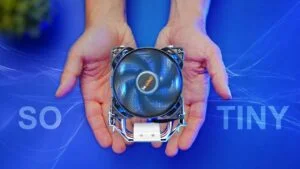Intel i9-9980XE Performance Review
Share:
Intel has been on something resembling a war footing as of late as they scramble to find a way to counteract AMD’s Ryzen and Threadripper surge. While it was more than evident that Team Blue was caught flat-footed by all things Zen, they’re obviously now racing out both new and refreshed processors. The first salvo was last month’s 9th Gen Coffee Lake CPUs and now we’re about to move on to the HEDT market with a refresh of Skylake-X.
Unfortunately, Intel’s once-darling 14nm manufacturing process is now their worst enemy since moving beyond it has proven to be a titanic undertaking. There’s no better example of this than the 9th generation high end desktop parts which Intel has simply described as “products formerly known as Skylake”. Basically, that means Intel’s “new” flagship CPUs are simply utilizing the three year old Skylake architecture rather than Coffee Lake or even Kaby Lake for that matter.

While the underlying microarchitecture of these “9th Gen” CPUs may is a senior citizen by today’s standards, this old dog is still learning new tricks. Endless 14nm enhancements have lead to improved clock speeds without overtly impacting TDP values. There’s also been a significant shift in some of the mid and lower priced SKUs so they’re more competitive with Threadripper alternatives.
Soldered TIM has also been utilized to lower overall temperatures and potentially improve overclocking. However, despite the fact motherboard manufacturers are releasing “new” X299 boards, there’s really nothing different with the platform itself. This is simply an excuse to refresh their respective lineups.

Sitting right at the top of Intel’s HEDT lineup will be the 18 core, 36 thread i9-9980XE which is basically a clone of the i9-7980XE but with a significantly higher Base Clock and slightly better Turbo frequencies. Through testing I noticed that it was able to hit consistently better frequencies than its predecessor regardless of how many cores were engaged. As you’ll see in the benchmarks, that led to a pretty impressive performance bump in some situations.
That same narrative of better speeds alongside identical specifications (and prices for that matter) continues with the i9-9960X and i9-9940X but stops when our chart hits the i9-9920X. Personally I think this CPU is one of the most interesting of this generation since it boasts a base clock that’s a whopping 600MHz higher than the outgoing 7920X and Intel has equipped it with more L3 Smart Cache. This combination could make it a potent competitor against the Threadripper 2950X despite a cost that’s a good $300 higher than AMD’s alternative. The 9920X will require more power than the 7000-series CPU it replaces but that’s a small price to pay.

Moving further down into the lineup and things continue to get interesting. The 9900X gets a 200MHz boost in its Base Clock rates but that move from 13.75 to 19.25MB of Smart Cache will likely benefit performance more than any frequency modification could have. Remember, in many ways the 7900X was Skylake-X’s darling since it combined a somewhat reasonable price with great frequencies and 20 concurrent threads. I still use one in my primary gaming and editing PC.
The next stop on our whirlwind tour is the oddball of Intel’s new lineup: the i9-9820X. Like the 9900X it has 20 threads but it also operates at significantly lower clock speeds and it has nearly 3MB less L3 cache. And yet it costs just $100 less. Its obvious Intel wants this CPU to run up against AMD’s 2950X but I have to wonder why they didn’t just lower the 9900X’s price by $100 for a more convincing alternative. Sure it has 44 CPU-based PCIe lanes but that’s par for the course these days.
Intel has chosen the i7-9800X as the i7-7820X’s true replacement and with it comes the expected price increase to $600 (versus the 7800X’s $400) and 44 PCIe lanes. Honestly, it seems these two 9800X-series processors are positioned in such a way to make room for the i9-9900K rather than being reactive to anything within the competitive landscape.
So that’s the quick and dirty look at Intel’s refreshed lineup and in all reality, if the original Skylake-X processors didn’t appeal to you, there’s likely nothing here to change your opinion. But let’s go through the motions of benchmarking the i9-9980XE to see if there are any surprises in store.
Test Setups & Methodology
For this review, we have prepared a number of different test setups, representing many of the popular platforms at the moment. As much as possible, the test setups feature identical components, memory timings, drivers, etc. Aside from manually selecting memory frequencies and timings, every option in the BIOS was at its default setting.

For all of the benchmarks, appropriate lengths are taken to ensure an equal comparison through methodical setup, installation, and testing. The following outlines our testing methodology:
A) Windows is installed using a full format.
B) Chipset drivers and accessory hardware drivers (audio, network, GPU) are installed.
C)To ensure consistent results, a few tweaks are applied to Windows 10 and the NVIDIA control panel:
- UAC – Disabled
- Windows HPET – Disabled
- Indexing – Disabled
- Superfetch – Disabled
- System Protection/Restore – Disabled
- Problem & Error Reporting – Disabled
- Remote Desktop/Assistance – Disabled
- Windows Security Center Alerts – Disabled
- Windows Defender – Disabled
- Screensaver – Disabled
- Power Plan – High Performance
- V-Sync – Off
- All BIOS-enabled performance enhancements – Disabled
System Benchmarks: AIDA64
AIDA64 Extreme Edition
AIDA64 uses a suite of benchmarks to determine general performance and has quickly become one of the de facto standards among end users for component comparisons. While it may include a great many tests, we used it for general CPU testing (CPU ZLib / CPU Hash) and floating point benchmarks (FPU VP8 / FPU SinJulia).
CPU PhotoWorxx Benchmark
This benchmark performs different common tasks used during digital photo processing. It performs a number of modification tasks on a very large RGB image:
This benchmark stresses the SIMD integer arithmetic execution units of the CPU and also the memory subsystem. CPU PhotoWorxx test uses the appropriate x87, MMX, MMX+, 3DNow!, 3DNow!+, SSE, SSE2, SSSE3, SSE4.1, SSE4A, AVX, AVX2, and XOP instruction set extension and it is NUMA, HyperThreading, multi-processor (SMP) and multi-core (CMP) aware.

CPU ZLib Benchmark
This integer benchmark measures combined CPU and memory subsystem performance through the public ZLib compression library. CPU ZLib test uses only the basic x86 instructions but is nonetheless a good indicator of general system performance.

CPU AES Benchmark
This benchmark measures CPU performance using AES (Advanced Encryption Standard) data encryption. In cryptography AES is a symmetric-key encryption standard. AES is used in several compression tools today, like 7z, RAR, WinZip, and also in disk encryption solutions like BitLocker, FileVault (Mac OS X), TrueCrypt. CPU AES test uses the appropriate x86, MMX and SSE4.1 instructions, and it’s hardware accelerated on Intel AES-NI instruction set extension capable processors. The test is HyperThreading, multi-processor (SMP) and multi-core (CMP) aware.

CPU Hash Benchmark
This benchmark measures CPU performance using the SHA1 hashing algorithm defined in the Federal Information Processing Standards Publication 180-3. The code behind this benchmark method is written in Assembly. More importantly, it uses MMX, MMX+/SSE, SSE2, SSSE3, AVX instruction sets, allowing for increased performance on supporting processors.

FPU VP8 / SinJulia Benchmarks
AIDA’s FPU VP8 benchmark measures video compression performance using the Google VP8 (WebM) video codec Version 0.9.5 and stresses the floating point unit. The test encodes 1280×720 resolution video frames in 1-pass mode at a bitrate of 8192 kbps with best quality settings. The content of the frames are then generated by the FPU Julia fractal module. The code behind this benchmark method utilizes MMX, SSE2 or SSSE3 instruction set extensions.
Meanwhile, SinJulia measures the extended precision (also known as 80-bit) floating-point performance through the computation of a single frame of a modified “Julia” fractal. The code behind this benchmark method is written in Assembly, and utilizes trigonometric and exponential x87 instructions.

Productivity Benchmarks: 7-Zip / Adobe Premier Pro
7-Zip
At face value, 7-Zip is a simple compression/decompresion tool like popular applications like WinZip and WinRAR but it also has numerous additional functions that can allow encryption, decryption and other options. For this test, we use the standard built-in benchmark which focuses on raw multi-threaded throughput.

Adobe Premier Pro CC
Adobe Premier Pro CC is one of the most recognizable video editing programs on the market today as it is used by videography professionals and YouTubers alike. In this test we take elements of a 60-second 4K video file and render them out into a cohesive MP4 video via Adobe’s Media Encoder. Note that GPU acceleration is turned on.

Productivity Benchmarks: Blender / 3ds MAX Corona
Blender
Blender is a free-to-use 3D content creation program that also features an extremely robust rendering back-end. It boasts extremely good multi core scaling and even incorporates a good amount of GPU acceleration for various higher level tasks. In this benchmark we take a custom 1440P 3D image and render it out using the built-in tool. The results you see below list how long it took each processor to complete the test.

3ds MAX Corona Renderer
Autodesk’s 3ds MAX is currently one of the most-used 3D modeling, animation and rendering programs on the market, providing a creative platform for architects to industrial designers alike. Unfortunately its rendering algorithms leave much to be desired and third party rendering add-ons are quite popular. One of the newest ones is called Corona.
In this test we take a custom 3D scene of a room with global illumination enabled and render it out in 720P using Corona’s built-in renderer.

Productivity Benchmarks: GIMP / Handbrake
GIMP
While it may be open source, GIMP is actually one of the most popular free photo editors available right now. It uses both CPU and GPU acceleration for certain tasks. In this test we use an 8K image and use a script to run eight different filters in succession. This is considered a lightly threaded workload since the memory, CPU and storage drive can all play a role in performance.

Handbrake
Video conversion from one format to another is a stressful task for any processor and speed is paramount. Handbrake is one of the more popular transcoders on the market since it is free, has a long feature list, supports GPU acceleration and has an easy-to-understand interface. In this test we take a 6GB 4K MP4 and convert it to a 1080P MKV file with a H.264 container format. GPU acceleration has been disabled. The results posted indicate how long it took for the conversion to complete.

Productivity Benchmarks: POV Ray / WinRAR
POV Ray 3.7
POV Ray is a complex yet simple to use freeware ray tracing program which has the ability to efficiently use multiple CPU cores in order to speed up rendering output. For this test, we use its built-in benchmark feature which renders a high definition scene. The rendering time to completion is logged and then listed below.

WinRAR
WinRAR is one of those free tools that everyone seems to use. Its compression and decompression algorithms are fully multi-core aware which allows for a significant speedup when processing files. In this test we compress a 3GB folder of various files and add a 256-bit encryption key. Once again the number listed is the time to completion.

Gaming Performance (Synthetic)
3DMark Fire Strike (DX11)

3DMark Time Spy (DX12)


Gaming Performance (Battlefield 1 / COD: IW)
Battlefield 1
Battlefield 1 will likely become known as one of the most popular multiplayer games around but it also happens to be one of the best looking titles around. It also happens to be extremely well optimized with even the lowest end cards having the ability to run at high detail levels.
In this benchmark we use a runthough of The Runner level after the dreadnought barrage is complete and you need to storm the beach. This area includes all of the game’s hallmarks in one condensed area with fire, explosions, debris and numerous other elements layered over one another for some spectacular visual effects.

Call of Duty: Infinite Warfare
The latest iteration in the COD series may not drag out niceties like DX12 or particularly unique playing styles but it nonetheless is a great looking game that is quite popular.
This benchmark takes place during the campaign’s Operation Port Armor wherein we run through a sequence combining various indoor and outdoor elements along with some combat.

Gaming Performance (Deus Ex / DOOM)
Deus Ex – Mankind Divided
Deus Ex titles have historically combined excellent storytelling elements with action-forward gameplay and Mankind Divided is no difference. This run-through uses the streets and a few sewers of the main hub city Prague along with a short action sequence involving gunplay and grenades.

Doom
Not many people saw a new Doom as a possible Game of the Year contender but that’s exactly what it has become. Not only is it one of the most intense games currently around but it looks great and is highly optimized. In this run-through we use Mission 6: Into the Fire since it features relatively predictable enemy spawn points and a combination of open air and interior gameplay.

Gaming Performance (GTA V / Overwatch)
Grand Theft Auto V
In GTA V we take a simple approach to benchmarking: the in-game benchmark tool is used. However, due to the randomness within the game itself, only the last sequence is actually used since it best represents gameplay mechanics.

Overwatch
Overwatch happens to be one of the most popular games around right now and while it isn’t particularly stressful upon a system’s resources, its Epic setting can provide a decent workout for all but the highest end GPUs. In order to eliminate as much variability as possible, for this benchmark we use a simple “offline” Bot Match so performance isn’t affected by outside factors like ping times and network latency.

Power Consumption
There’s a pretty substantial story lurking behind the numbers you see below and how they directly relate to TDP claims from both Intel and AMD. Without getting too technical, the way these two companies go about measuring TDP is fundamentally different from one another. Intel themselves published a very comprehensive and quite neutral White Paper (Word doc download) about the differences a few years ago and its worth a quick read if you have a chance.
What you need to know is that TDP values are a universally poor way to determine actual power consumption for end users since they are simply thermal design guidelines that are given to system integrators. As I say in every review, TDP is not actual power consumption so don’t take it as such.
As both Intel and AMD recommend, the best way to measure true power deltas between processors is via a simple (yet calibrated) power meter plugged into the wall outlet. That’s exactly what we do but add in a controlled 120V power input to eliminate voltage irregularities from impacting the results.

You might remember that in our 9900K review there was a small issue with that CPU’s power consumption being unexpectedly low. After some investigation it seems like AIDA64’s System Stability Test’s algorithms were changed in such a way that they maxed out temperatures but didn’t max out package’s power input. I am now back to using an older version of AIDA only for this test so the results can remain consistent. In the future we may look into switching completely away from this application.
With that being said, the i9-9980XE is one power hungry CPU and it goes to show that Intel’s 14nm manufacturing process has reached its last leg of competitiveness; at least with the Skylake architecture. While Kaby Lake and Coffee Lake evolutions allowed for additional power tuning features, Skylake has none of those. So what you get is a 7-10% performance increase due to higher clocks and a very much linear increase in power needs as well. Intel really needs to quickly move beyond 14nm if they have any hope of competing with AMD’s upcoming 7nm refreshes.
Conclusion – Another Incremental Step
There’s no denying the fact that when viewed in a vacuum the i9-9980XE is an extremely impressive CPU. Its preeminent place in the charts isn’t by chance since the frequency increases from Intel’s previous generation pay some massive dividends in certain applications.
Speaking of performance, the delta between the i9-9980XE and i9-7980XE varies wildly from one program to another. When it comes to full tilt, balls-to-the-wall 36 thread throughput, the newer CPU is often in a dominating position. Apps like Blender and Corona Renderer show this off perfectly.
Other programs like Adobe Premier are still multi threaded but they don’t fully utilize all of a processor’s cores and those show a much narrower performance gap. Games, photo editing programs like GIMP and other lightly threaded applications have CPUs pretty evenly matched. I’ve mentioned this time and again: you don’t need a massively powerful CPU to attain incredibly high framerates and our benchmarks showed this yet again.
From a competitive perspective, it’s too bad we haven’t had a chance to benchmark AMD’s 2990WX or 2970WX quite yet since I’m sure both of those would put Intel’s 18-core flagship to shame in some key multi core focused applications. They also happen to cost less. Meanwhile, the 2950X is an extremely capable processor in its own right and it happens to cost a whopping $1,100 less than the i9-9980XE. For those keeping track at home, you can buy a 2950X, an X399 motherboard and a GTX 2080 for the price of a single 9980XE. X399 is arguably a more capable platform as well.
You’ll also notice the conspicuous lack of an overclocking section in this review. As with all of these monster CPUs, overclocking grants limited returns since Intel’s Turbo 3.0 is better able to adjust CPU frequencies based on workload than a limited all-core overclock. In addition the motherboard’s VRM is often the limiting factor rather than cooling. That’s exactly what happened here; while I was able to hit 4.05GHz on all cores, the STRIX-E’s VRMs hit a stratospheric 100C which eventually throttled clock speeds despite CPU package temperatures around the 81C mark. So basically overclocking ended up being a dead end.
With every single Intel CPU launch comes complaints of higher-than-claimed prices once the CPUs hit retail. Ironically this isn’t something that’s happened to AMD so the blame has to be equally spread between Intel’s nebulous “1K pricing” and retailer markups. Either way, its time this infuriating problem is fixed.
But past the raw cost of $2,000, there could very well be a market that views something like the i9-9980XE as a good value. For professionals time is money and if the investment of $2,000 saves them a few hours of rendering time every month, they’d obviously jump at the opportunity to increase productivity. The same goes for heavy multi taskers and while Windows still struggles with core affinity, its these types of folks who are being well targeted by Intel here.
With that said, Intel is quite obviously struggling with their inability to move beyond 14nm and its starting to hurt them in the power consumption department. While the average multi core performance increase versus the previous generation can range from 7% to 14%, so too does the overall power consumption envelope. Luckily it seems the STIM application does indeed tame heat output (our 18-core sample had no issue being cooled by a Noctua NH-U14S) but the i9-9980XE still sucks down a pretty hefty amount of juice.
I also have a bone to pick with Intel’s sampling guidelines. While it’s understandable they want us to talk about a flagship part, I feel there’s some compelling stories being left untold at launch. For example, the i9-9920X and i9-9900X have received some very meaningful upgrades which should make them more competitive with AMD’s 2950X. This is in sharp contrast to what AMD does since they seem willing to give us an immediate glimpse at what their entire lineup has to offer.
So there you have it; another incremental update for Intel but in some situations it could be more than that. Naturally pricing will come up again and again since –while Intel does seem to be reacting to AMD’s offerings- the i9-9980XE’s cost of $2,000 is stratospherically high and it also seems a bit tone-deaf to Threadripper’s positioning. But even with that taken into account, there’s still a ready and willing market for what the 9980XE has to offer.




